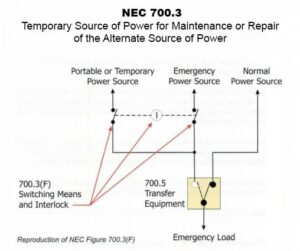The National Electrical Code (NEC) is the standard that all electrical companies and electrical systems must follow. The NEC is used to ensure that electrical systems are installed in a manner that protects people and property by minimizing the risks associated with the use of electricity. This means it’s updated to remain as safe as possible as new technology, methods, and equipment are invented and introduced.
The NEC becomes even more important when hurricane season rolls around because then businesses are bound to be using standby power more than any other time of the year. With the 2020 hurricane season here and gearing up for its most active time, it’s important to understand the 2017 and 2020 changes to Sections NEC 700.3 and 702.12 that deal with installing and maintaining emergency back-up power systems.
For electrical experts, the code makes sense, but it may seem like a foreign language when business owners try to read the code changes to update their building’s emergency power systems. The power distribution experts at Power Temp Systems are here to decipher these code changes for you.
How to Adjust Your Standby Power System to Comply to NEC 700.3 Changes
The simplest way to comply with this code change is to use a docking station to mitigate power between your permanent generator and a set of Cam-Lok™s located on the transfer switch enclosure. This allows a temporary generator to be simply plugged in.
 The changes outlined in the latest version of the NEC say that you can’t disconnect the existing wiring and hardwire the back-up generator, because quite frankly it’s just unsafe, time-consuming, and requires an electrician to come out to your facility to install the generator. The changes also outline that the back-up power source must be capable of switching over quickly. The code change says the switch must happen within 10 seconds.
The changes outlined in the latest version of the NEC say that you can’t disconnect the existing wiring and hardwire the back-up generator, because quite frankly it’s just unsafe, time-consuming, and requires an electrician to come out to your facility to install the generator. The changes also outline that the back-up power source must be capable of switching over quickly. The code change says the switch must happen within 10 seconds.
A quick-connect docking station is the easiest and simple solution to abide by these changes in the code. As the name alludes, quick connect docking panels allow for the quick and safe connection of a standby generator without having to call an electrician for installation. The panels also allow for an autostart once the utility power is knocked out by severe weather.
Phase rotation and system bonding are another issue touched on in the new NEC changes. They must be identical between the primary and back-up power sources. Docking stations allow phase rotation and system bonding to be identical between the primary and back-up power sources with a phase rotation monitor. One green light indicates a correct connection, or a red light indicates a mismatch and the system presents instructions on how to correct the mismatch.
Docking stations also make it impossible to parallel or back feed the permanent and temporary generator, which protects the technician servicing the generator. This is one of the other major changes in the new NEC. Power Temp docking stations offer custom configurations to cover any application. If the generator isn’t correctly reconnected after servicing, an alarm is there to alert users of any connection mistakes.
The new codes highlight user safety which should always be the priority when developing and modifying these standards for electrical safety. The new NEC changes apply to any building occupied by large numbers of people including hotels, sports arenas, libraries, hospitals, nursing homes, schools, universities, and many other types of buildings and businesses. Almost any business could benefit from installing a docking station for their standby power source, especially with hurricane season upon us. Power Temp Systems offers a full line of NEC 700 compliant docking stations, as well as quick-connect tap boxes.
